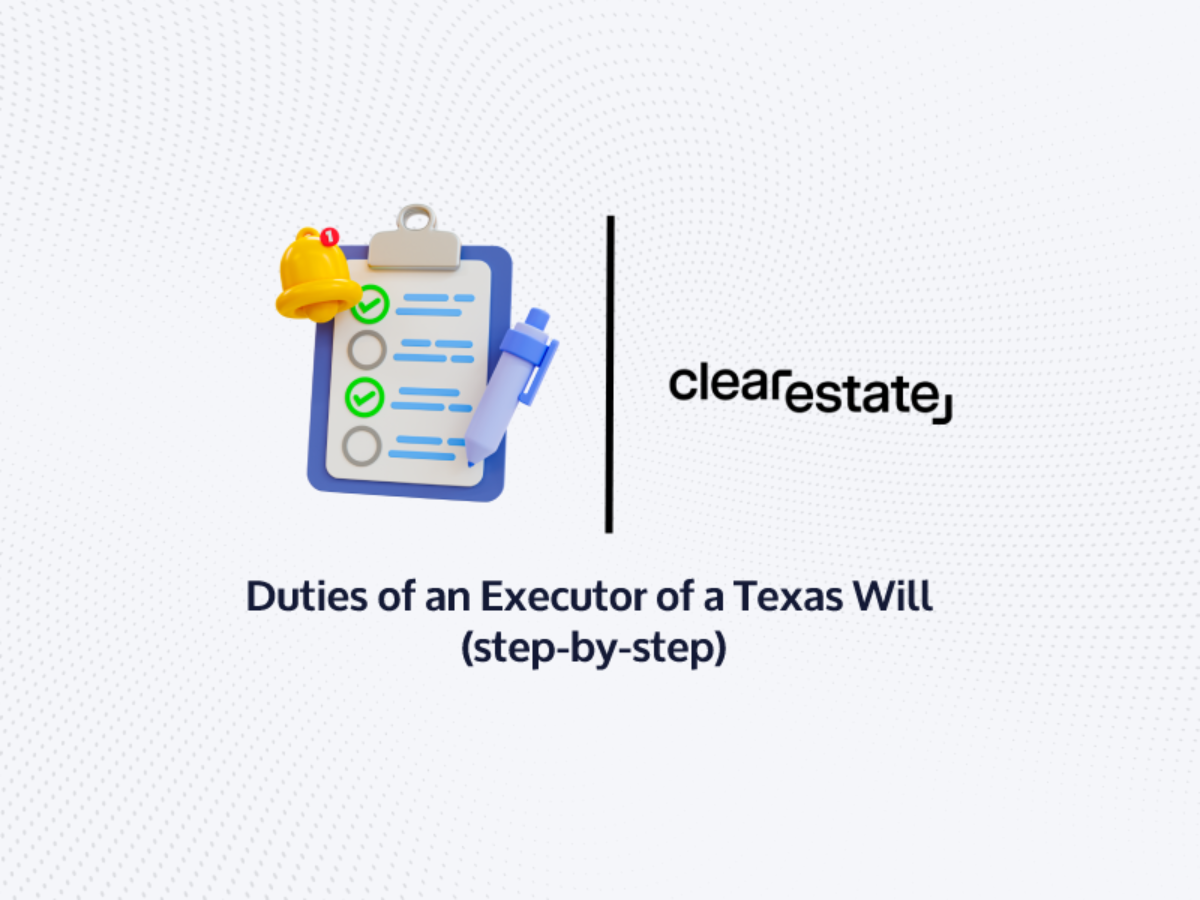Estate Settlement
May 01, 2025
What to Do When Someone Dies in California
Follow this step-by-step guide to navigate legal duties, probate, and estate tasks with clarity and confidence.
Are you an executor of a will in Texas? Learn your executor duties with our clear, step-by-step guide. - manage your loved ones estate confidently and efficiently.


Article Contents
Being appointed as the personal representative of an estate (executor or administrator) can be a daunting task that comes fraught with a complicated array of duties, including filing a petition for probate, which is the legal process in which a decedent’s estate is settled. People are counting on you, and you can count on us.
Our probate checklist is just a free tool we offer Texans to help clarify and simplify the probate process. Our goal is to save you time and money while reducing stress and uncertainty by being a trusted guide and taking a huge burden off your shoulders.
GOAL: Arrange for funeral
WHEN: Immediately after death
DURATION: 5 to 10 days
Order more death certificates than you think you may need. Every financial institution will ask for one.
A good rule of thumb to follow: Order a death certificate for each real estate property and bank account.
GOAL: Determine which type of estate administration is required. There are four different types of estate administration processes in the state of Texas.
WHEN: 0 to 30 days after the funeral
DURATION: 2-3 weeks
In Texas, independent administration of an estate can occur under two circumstances;
The first is when a decedent specifies in their will that the estate should be administered without the court's oversight.
The second scenario arises when a decedent dies without a will, and all beneficiaries agree on the appointment of an Independent Administrator. Independent administration is often faster and more cost-effective, as the Independent Administrator can perform their duties without needing court approval for each step of the process, saving time and money.
Unanimous Consent of Heirs
To proceed with an independent administration, all heirs of the decedent's estate must agree on this approach; otherwise, the court will only permit a dependent administration. The heirs must also reach a consensus on the nomination of an Independent Administrator.
As long as the heirs agree and consent, the estate can be managed through an independent administration with an Administrator chosen by the collective heirs. If an heir is a minor or an incapacitated person, consent can only be obtained from the Guardian of the Estate for that individual.
By opting for independent administration in Texas, the estate can be managed more efficiently, reducing both the time and costs associated with court involvement. This streamlined process can be beneficial for all parties involved, ensuring a smoother transition and distribution of assets.
Dependent estate administration in Texas involves court supervision, contrasting with independent estate administration, which operates with minimal court oversight. This type of administration is typically seen when there is a surviving spouse and minor children, or when there is no named executor and disputes among beneficiaries arise, or when the decedent died without a will (intestate).
In a dependent estate administration, the Administrator is required to post a bond and obtain Court approval for all actions taken as the estate Administrator. The bond functions like an insurance policy, necessitating the payment of a premium to an insurance company to safeguard against mismanagement or misappropriation of assets by the Administrator. This process ensures that the estate is managed responsibly and in accordance with the law.
Moreover, the Administrator must provide annual inventory accounting every year within 60 days from their qualification date. This requirement ensures that the estate's assets are regularly tracked and accounted for throughout the administration process. Additionally, the Administrator must file an application to close, discharge, and release the bond once the estate administration is completed. This step signifies the conclusion of the Administrator's responsibilities and the official closure of the estate.
Lastly, the Administrator is obligated to file a final accounting report. This document details the financial transactions and distributions made during the estate administration process, providing a transparent record of the Administrator's actions. The combination of these steps and court supervision aims to ensure a fair and orderly administration of the estate, protecting the interests of all parties involved.
A Small Estate Affidavit is a useful legal tool in specific situations where a decedent passes away without a will (intestate) and their total estate value is worth $75,000 or less, excluding homestead property and exempt property.
In these cases, there's no need for a formal administration or the appointment of an administrator. This simplified process applies only when the assets in the estate are worth more than the debts, not considering any mortgages or debts secured by exempt property as debts and not counting homestead and exempt property as assets.
The Small Estate Affidavit is applicable when the only real property owned by the decedent was their homestead property.
When the decedent died with a will (testate), had no unpaid debts except ones secured by liens on real estate
• Hearing to probate will and transfer title without the need of formal administration
• No executor/administrator appointed.
GOAL: If proceeding with General Administration or Summary Administration, you will collect and manage the decedent’s assets
WHEN: Immediately after letters are issued
DURATION: 2 to 9 months
Once the estate's probate procedure is figured out, whether; Independent, dependent, small estate, muniment of title - the person representative of the estate will still have similar duties when it comes to estate settlement.
GOAL: Create an inventory of all the decedent’s assets and liabilities
WHEN: 10 to 45 days after the funeral
DURATION: 1-3 weeks
*** DO NOT CANCEL THE SOCIAL SECURITY NUMBER UNTIL TAXES HAVE BEEN FILED
GOAL: Complete an Inventory of the estate
WHEN: Deadline for filing the inventory is 90 days from the date of appointment
DURATION: 2 to several weeks
The inventory must include:
The personal representative shall:
Attach to the inventory, appraisement, and list of claims the representative’s affidavit, subscribed and sworn to before an officer in the county authorized by law to administer oaths, that the inventory, appraisement, and list of claims are a true and complete statement of the property and claims of the estate of which you have knowledge.
File the inventory with the Court.
Mail a copy of the inventory to the heirs, if applicable under law.
Or file an affidavit in lieu of inventory (not for Formal Dependant Estate Administration) If there are no unpaid debts, except for secured debts, taxes, and administration expenses, at the time the inventory is due, including any extensions. $1000 fine for failure to file.
Provide an affidavit stating that all debts, except for secured debts, taxes, and administration expenses, are paid and that all beneficiaries, if applicable, have received a verified, full, and detailed inventory and appraisement.
A complete list of claims due or owing to the estate must be attached to the inventory and appraisement. The list of claims must state:
GOAL: Ready the estate for distribution by settling the debts and addressing any lingering tax issues
WHEN: After period to file a claim against the estate has elapsed
DURATION: 2 to 6 weeks
GOAL: Prepare the Petition for Final Distribution and begin closing the estate
WHEN: Within 18 months of initial appointment as personal representative
DURATION: 2-4 weeks
Sale of Property: Under the decedent’s will you may sell property without court approval on terms and at the price you consider fair and reasonable to the estate. There is no timeframe listed in the Texas code (law) but best practices would be to wait until creditor claims are barred in case you need to pay them.
Pay self: Executor compensation (5% of all amounts that the executor or administrator actually receives or pays out in cash in the administration of the estate), not to exceed the estate gross value.
New titles are issued for cars, boats and other titled property.
Distribute remaining assets to beneficiaries.
File any Distribution or Administrator deeds if applicable.
Most Independent Administrations are not formally closed and are not required however the executor may close the estate by:
In a Dependent Administration, executors are required to file a final accounting with the court to close the administration.
We understand that being an executor of a will is no easy task. Shouldering the responsibility, managing the probate process, and investing the time it takes to fulfill the role can make it easy to feel lost.
That's why ClearEstate is here to help. By booking a free consultation with us, you'll receive expert guidance, and the support you need to help you get through this challenging process.
Book a FREE consultation with us today and get the expert help you need with ClearEstate's team of specialized probate professionals.
 Simplify Probate Today
Simplify Probate Today
Get expert guidance from our specialists who've helped 10,000+ families.
Book a free consultation